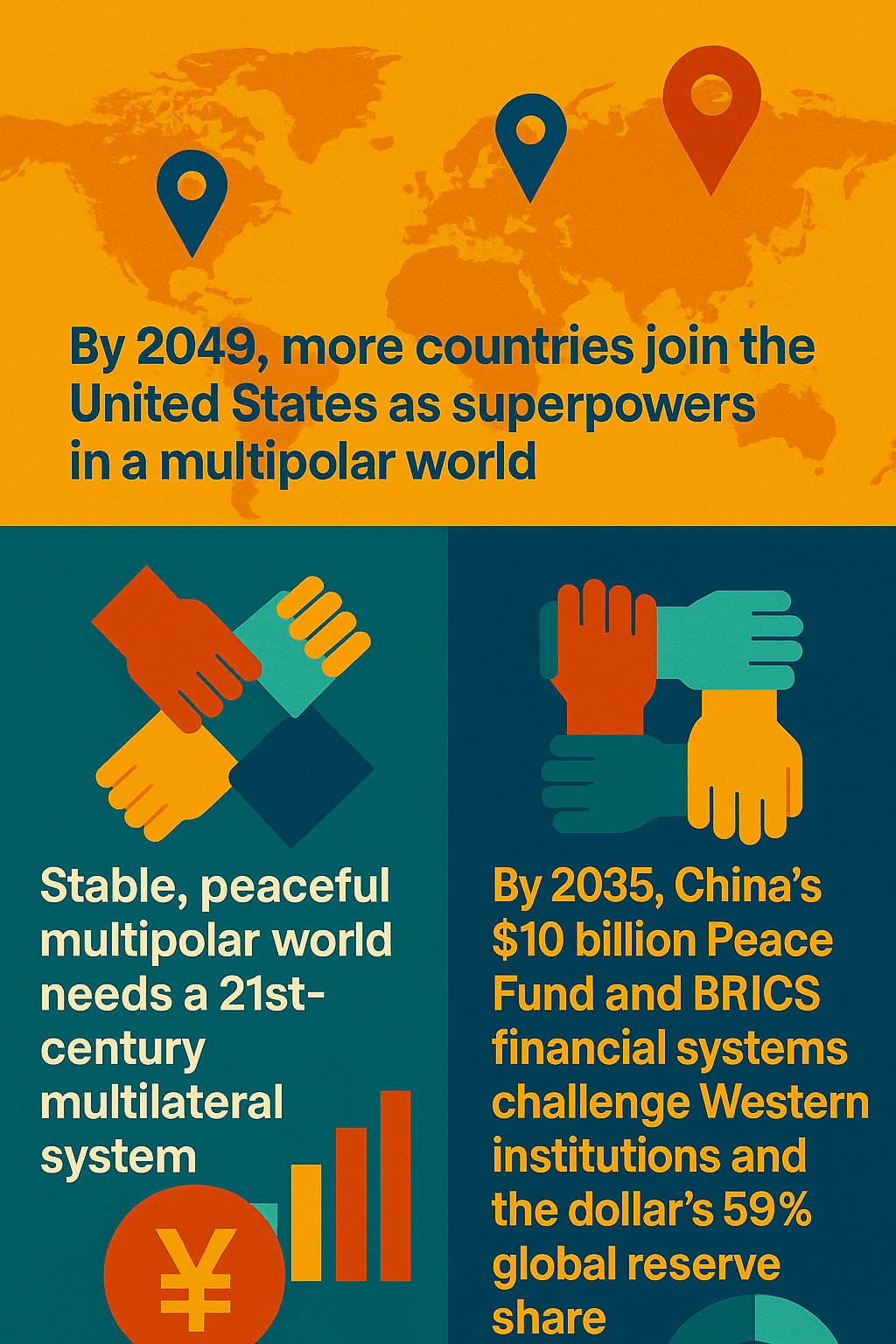Global Scans · Shifting Global Power & Multipolarity · Signal Scanner
Emerging Financial Architectures in a Multipolar World: The Rise of Alternative Global Currency Systems
The gradual shift from a unipolar to a multipolar global order is generating weak signals of change in the international monetary system that could disrupt traditional economic frameworks. Beyond the much-discussed competition between the US dollar and the Chinese yuan, a growing constellation of new financial institutions, currency coalitions, and decentralized technologies may recalibrate how global trade and reserves are managed. This emerging trend—characterized by diversification away from Western-dominated financial infrastructure—may redefine power balances between nations, industries, and investors over the next two decades.
What’s Changing?
Historically, global finance has centered around institutions and currencies controlled primarily by Western powers, with the US dollar retaining approximately 59% of global reserves (Geopolitics Unplugged). However, recent developments signal a shift toward a more pluralistic, multipolar financial ecosystem.
One significant change involves China’s efforts to bolster an alternative financial bloc through initiatives like the $10 billion Peace Fund and the BRICS New Development Bank. These institutions may strengthen intra-regional trade and investment ties among emerging economies, gradually supplanting Western institutions such as the International Monetary Fund (IMF) and the World Bank in some contexts (USIP; dras.in). The expansion of BRICS and associated financial frameworks reflect a coordinated strategy to diversify away from dollar dependency and establish parallel currency arrangements (Medium; TradingView).
Simultaneously, digital finance and blockchain innovations contribute to a decentralization of global transactions. Blockchain’s transparency, immutability, and programmable contract logic provide a technical foundation for currency alternatives and cross-border payments that bypass traditional financial gatekeepers (Edge-Forex). This technological layer may accelerate a shift towards digital currencies, both sovereign and private, increasingly relevant in multipolar geopolitical alignments.
The evolution toward a multipolar world also impacts supply chain strategies. Businesses are diversifying physically and financially by retooling supply chains to accommodate multiple centers of power. This diversification creates new demands for critical raw materials essential for infrastructure and technology development within emerging economic blocs, further reinforcing the need for localized or regional financial mechanisms that support these economic activities (Baillie Gifford).
Lastly, the United States’ tightening of technology access and export restrictions on China epitomizes the growing decoupling of economic blocks and networks, potentially accelerating the emergence of parallel financial and trade systems (Business Aviation Aero). As US–China rivalry intensifies, multinational corporations and governments face increasing pressure to navigate bifurcated business environments, raising the stakes for new financial architectures that can operate independently of Western financial infrastructure.
Why is this Important?
The financial reconfiguration underway poses critical strategic challenges and opportunities for governments, businesses, and investors worldwide. If successful, alternative financial institutions and digital currency platforms could diminish the dominance of the US dollar and Western-led credit systems, potentially reducing the influence of established economic powers.
For governments, this diversification could enhance economic sovereignty and reduce vulnerability to external sanctions or financial coercion. Emerging economies may strengthen their bargaining power and increase regional investment, enabling projects tailored to their strategic priorities without reliance on Western lenders.
International businesses would need to adapt to multiple competing financial frameworks, increasing complexity but also opening up innovation in cross-border transactions, financing, and risk management. The shift might lead to new forms of trade agreements and currency swaps, driven by digital finance technologies that promise speed and transparency unavailable in legacy systems.
The weakening of dollar hegemony may also alter interest rates, inflation expectations, and capital flows globally, affecting markets across sectors including commodities, manufacturing, and technology. Investors might reassess risk allocations based on the stability and inclusiveness of emerging multipolar financial networks.
Implications
This emerging trend points to several strategic imperatives. Governments should monitor alternative finance institution developments and assess their potential impact on international economic policy and trade relations. Engaging proactively with these institutions may offer diplomatic and economic leverage as global multipolarity unfolds.
Businesses must reevaluate their international risk exposures, supply chain dependencies, and financial operations to accommodate a fragmented but interconnected global economic landscape. Strategic scenario planning around currency diversification and payment system interoperability could become critical to safeguarding operational resilience.
Research and development investment in blockchain and digital finance technologies may accelerate as countries and corporations seek decentralized solutions that can bridge diverse monetary systems. Leadership in digital currencies, smart contracts, and cross-border payment infrastructure could offer a competitive advantage in the coming multipolar financial environment.
Moreover, international cooperation will remain essential to ensure that new financial architectures do not simply replicate the exclusivity of older systems but instead promote inclusivity and transparency critical for global economic stability.
Questions
- How might businesses restructure their financial and supply chain strategies to mitigate risks posed by fragmented global currency systems?
- What opportunities and challenges do emerging financial institutions like the BRICS Development Bank present for investors seeking diversified portfolios?
- In what ways could blockchain-based financial technologies reshape regulatory frameworks and international cooperation in monetary policy?
- How could multipolar currency dynamics affect commodity markets critical to infrastructure and technology development?
- What frameworks could governments and global institutions develop to support peaceful transition toward a multipolar financial order?
Keywords
multipolar world; BRICS New Development Bank; de-dollarization; digital currency; blockchain technology; financial decentralization
Bibliography
- Xi Jinping’s Power Consolidation Beyond 2035. Geopolitics Unplugged
- Trump’s Quixotic Fossil Fuel Agenda and the Multipolar Shift. The Ecologist
- Any Other Business Questions From Disruption Week—2024 Q4. Baillie Gifford
- The Future of Exchange Rate Dynamics in a Globalized Economy. TradingView
- What’s Driving Bigger BRICS and What Does It Mean for the US? United States Institute of Peace
- Navigating the 2030 Great Reset: A Ray Dalio Blueprint for Global Realignment. Medium
- How De-Dollarization Is Reshaping the Global Economy in 2025. Edge Forex
- Alaska 2025: An Agreement Without Europe, the Last Bastion of Globalism. Dras
- The Low Altitude Economy Explained: The Dramatic Transformation of Urban Air Space. Business Aviation Aero
